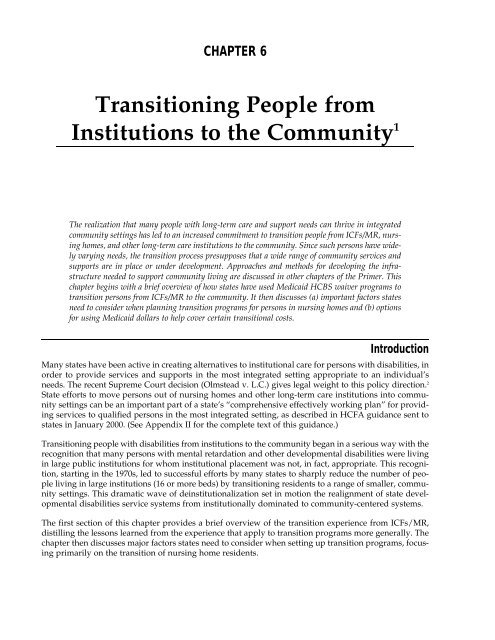Full PDF Version - ASPE - U.S. Department of Health and Human ...
Full PDF Version - ASPE - U.S. Department of Health and Human ...
Full PDF Version - ASPE - U.S. Department of Health and Human ...
- No tags were found...
Create successful ePaper yourself
Turn your PDF publications into a flip-book with our unique Google optimized e-Paper software.
CHAPTER 6Transitioning People fromInstitutions to the Community 1The realization that many people with long-term care <strong>and</strong> support needs can thrive in integratedcommunity settings has led to an increased commitment to transition people from ICFs/MR, nursinghomes, <strong>and</strong> other long-term care institutions to the community. Since such persons have widelyvarying needs, the transition process presupposes that a wide range <strong>of</strong> community services <strong>and</strong>supports are in place or under development. Approaches <strong>and</strong> methods for developing the infrastructureneeded to support community living are discussed in other chapters <strong>of</strong> the Primer. Thischapter begins with a brief overview <strong>of</strong> how states have used Medicaid HCBS waiver programs totransition persons from ICFs/MR to the community. It then discusses (a) important factors statesneed to consider when planning transition programs for persons in nursing homes <strong>and</strong> (b) optionsfor using Medicaid dollars to help cover certain transitional costs.IntroductionMany states have been active in creating alternatives to institutional care for persons with disabilities, inorder to provide services <strong>and</strong> supports in the most integrated setting appropriate to an individual’sneeds. The recent Supreme Court decision (Olmstead v. L.C.) gives legal weight to this policy direction. 2State efforts to move persons out <strong>of</strong> nursing homes <strong>and</strong> other long-term care institutions into communitysettings can be an important part <strong>of</strong> a state’s “comprehensive effectively working plan” for providingservices to qualified persons in the most integrated setting, as described in HCFA guidance sent tostates in January 2000. (See Appendix II for the complete text <strong>of</strong> this guidance.)Transitioning people with disabilities from institutions to the community began in a serious way with therecognition that many persons with mental retardation <strong>and</strong> other developmental disabilities were livingin large public institutions for whom institutional placement was not, in fact, appropriate. This recognition,starting in the 1970s, led to successful efforts by many states to sharply reduce the number <strong>of</strong> peopleliving in large institutions (16 or more beds) by transitioning residents to a range <strong>of</strong> smaller, communitysettings. This dramatic wave <strong>of</strong> deinstitutionalization set in motion the realignment <strong>of</strong> state developmentaldisabilities service systems from institutionally dominated to community-centered systems.The first section <strong>of</strong> this chapter provides a brief overview <strong>of</strong> the transition experience from ICFs/MR,distilling the lessons learned from the experience that apply to transition programs more generally. Thechapter then discusses major factors states need to consider when setting up transition programs, focusingprimarily on the transition <strong>of</strong> nursing home residents.
















